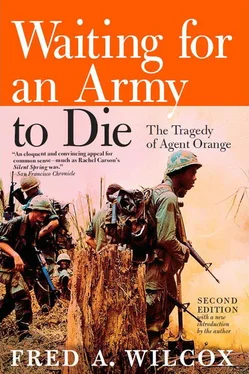“I celebrated that night, the night when this decision came out,” says Wares. “I tell you, I had a party that night. What a breakthrough. What they said was that it was possible and highly likely, that his exposure to chemicals caused his cancer. What they didn’t say was that his exposure definitely caused the cancer. But what is important is that they mentioned ‘toxic chemicals.’ Because in Australia we have written off the Agent Orange issue because we don’t want to give the government the chance to eliminate any of the substances to which we were exposed and therefore close the issue. So we’re including in our arguments Agent Blue, White, Pink, and Green. What we would like to know is what happens when you get all of these chemicals together. When you use them indiscriminately like they did in Vietnam, then what the hell can that do to a human being? We know that all of them except Blue contained some form of dioxin, and that Collin Simpson is dead and a lot of others are dying, not to mention the veterans who are screwed up, really in bad shape, and the kids who are still being born with serious problems.”
Although the tribunal’s decision has been hailed as a major precedent by American and Australian Vietnam veterans, Wares and Gibson realize that it is only one step down the long road toward winning compensation for those who are so seriously ill that they cannot work, and for the survivors of those who have died. Responding to the tribunal’s decision, Senator Messner remarked that it should be regarded only as a single case. He had “always encouraged veterans to take their claims before the Repatriation Commission and would continue to do so.” But veterans’ advocates, having spent $250,000 on legal fees for the Simpson case, argue that this approach could take years and require millions of dollars, and that what is needed is a judicial inquiry into the government’s handling of the toxic chemical issue, and inquiry that Senator Messner has steadfastly opposed.
“I’ve said it before and I’ll say it again, mate,” Wares announces. “You could fill up this bloody room with gold bars and it wouldn’t compensate for Cameron’s birth defect. Nothing will ever compensate for what’s happened to the guys who went to Vietnam, and to their families. Nothing. We don’t want money. That’s just a bunch of bullshit. No one really cares about the fucking money. What we want people to know is just what has gone on, the bullshit we’ve put up with, the cover-ups, the…”—Ware’s voice fades and slides, then regains composure, clarity—“Someday people will look at this thing, the whole thing, and they’ll be amazed, they’ll just be amazed and, I would think, damn frightened when they realize what’s happened to us could very well happen to them. I hope to Christ it never does, mate. I just really hope it never, never happens to anyone else.”
The VA’s record on Agent Orange is so bad that it almost defies belief. Nobody, you will feel, would be that insensitive. And so, precisely to the degree I tell you the truth, that degree I fear I will seem irrational, unresponsible.
—Robert O. Muller, executive director, Vietnam Veterans of America, testifying before the Subcommittee on Medical Facilities and Benefits
With an annual budget of approximately $24 billion, a staff of nearly a quarter million, and an empire that includes 172 regional hospitals and fifty-eight regional and local offices, the Veterans Administration is the US government’s second largest bureaucracy. But in spite of the enormous sums of money it spends to maintain its programs and hospitals, pay its bureaucrats, and at least appear to take seriously the mandate given it by Congress to work on behalf of America’s veterans, the VA’s record on the Agent Orange issue is abysmal.
Just two years after the last helicopter lifted off the roof of the US embassy in Saigon, the VA began receiving calls and letters from Vietnam veterans who believed they had been exposed to Agent Orange. The veterans complained of chronic skin rashes, fatigue, cancer, respiratory problems, impaired hearing or vision, depression, and loss of libido. Their wives, veterans told the VA, were giving birth to stillborn and deformed children and had suffered numerous miscarriages.
In 1977, Maude DeVictor was working in the Benefits Division of the VA’s regional office in Chicago when she received a call from the wife of a Vietnam veteran named Charles Owen. Her husband was dying, Mrs. Owen said, and he believed his terminal cancer was the result of exposure to Agent Orange. DeVictor had never heard of Agent Orange, but when she received another call from Mrs. Owen telling her that Charles had died and that the VA had refused her claim for survivor’s benefits, she decided to learn something about this obscure-sounding chemical.
She began by asking the widows of Vietnam veterans whether their husbands had been exposed to Agent Orange. She asked each veteran who visited or called her office a series of questions, including: “Were any of your children born with birth defects? How many miscarriages has your wife had? Do you suffer from skin rashes?” Astonished, many veterans replied: “How did you know?” When her supervisor demanded she stop gathering statistics and get back to business as usual, DeVictor refused. Instead, she contacted Bill Kurtis, a local television news correspondent whose skepticism gave way when he examined DeVictor’s findings. In March 1978, WBBM, a CBS affiliate in Chicago, aired an hour-long documentary entitled Agent Orange, the Deadly Fog . In the following weeks DeVictor received hundreds of calls from veterans who were sick or dying from symptoms remarkably similar to those of laboratory animals exposed to TCDD-dioxin.
By 1978, articles about Agent Orange were appearing in local and national publications, and officials at the VA decided it was time to begin mapping a strategy for dealing with the veterans’ complaints. First, the VA held a series of meetings from which veterans, independent scientists, and members of the public were excluded. Meeting behind closed doors with representatives of the chemical industry, the VA established its “no health effects” position on Agent Orange, thus commencing what the National Veterans Law Center (NVLC) calls “a two-year history of closed and secretive decision making.” 1
Approximately one year after its first closed Agent Orange meeting, the Veterans Administration, faced with a lawsuit for violating the open-meeting provision of the Federal Advisory Act, agreed to invite scientists who were not employed by the chemical industry. The VA also established an Advisory Committee on the Health-Related Effects of Herbicides, but according to the NVLC, “the pattern of unlawful action had begun.” 2Although the advisory committee was a good idea in principle, it was clear from the beginning that the VA intended to ask for its advice only after crucial decisions had been made, placing the committee in the position of a surgeon who is called in for consultation a few hours after an operation has been performed. “As a practical matter,” reports the law center, “the advisory committee has been ineffective as a device to obtain scientific advice on Agent Orange matters. This is a result which is the agency’s by design, not the fault of committee members.” 3
Following the formation of the advisory committee in December 1978, the NVLC wrote the VA on behalf of the National Association of Concerned Veterans, suggesting that the agency conduct a comprehensive outreach program to locate veterans who might be experiencing “unusual” health problems and to encourage those veterans to visit regional VA hospitals for a complete medical examination. The NVLC also suggested that the VA conduct an epidemiological study “to determine whether an increased incidence of health problems was occurring among Vietnam veterans.” The letter questioned the VA’s policy of denying all Agent Orange disability claims when the agency had already stated that “it did not have adequate information on exposure or causation to decide intelligently the merits of those claims.”
Читать дальше











